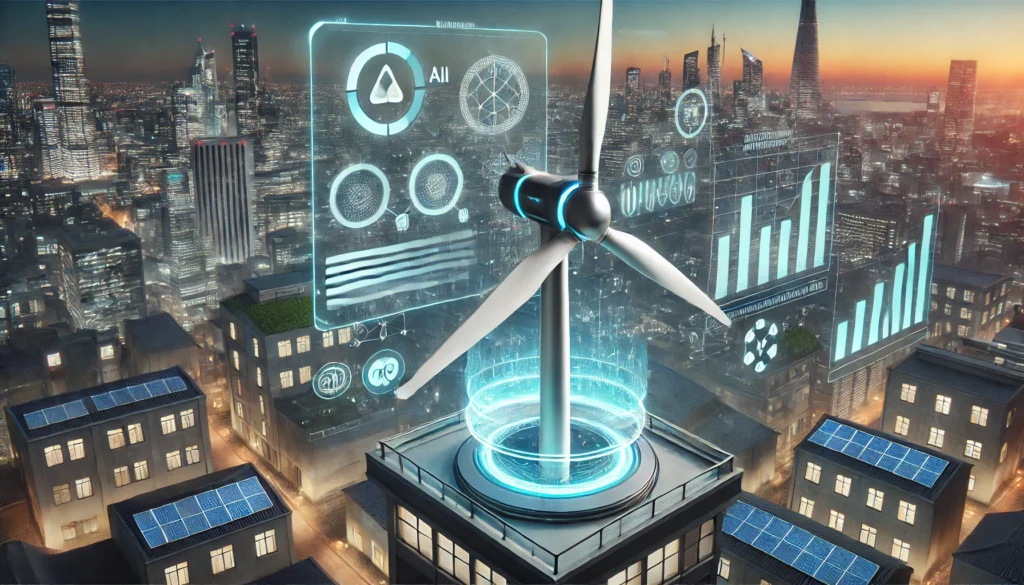As cities grow and energy demands rise, renewable energy solutions are becoming more crucial than ever. While solar power is widely adopted in urban environments, wind energy has historically faced challenges due to space limitations and inconsistent wind speeds. However, artificial intelligence (AI) is now transforming urban wind turbines, making them more efficient, adaptive, and viable for city landscapes.
This article explores how AI-powered wind turbines are reshaping urban energy solutions, covering notable advancements, innovative designs, and the potential for future development.
The Role of AI in Urban Wind Turbines
AI plays a critical role in enhancing the efficiency and design of wind turbines by:
- Optimizing blade design for maximum energy capture in low-wind urban environments.
- Predicting wind patterns to improve energy generation.
- Reducing maintenance costs through predictive analytics.
- Enhancing grid integration by adjusting power output in real-time.
By leveraging AI-driven simulations and machine learning algorithms, engineers can develop wind turbines that work efficiently in complex urban environments where traditional turbines fail.
The Birmingham Blade: A Breakthrough in AI-Designed Wind Turbines
One of the most innovative AI-designed urban wind turbines is the Birmingham Blade, developed by EvoPhase in collaboration with Kwik Fab Ltd. This turbine was entirely designed using AI to suit Birmingham’s unique wind conditions, which average only 3.6 meters per second—far lower than the 10 meters per second required for traditional turbines.
Key Features of the Birmingham Blade
- AI-driven design testing: Over 2,000 turbine designs were generated and tested using AI, significantly reducing development time.
- Curved blade structure: Unlike traditional turbines, the Birmingham Blade features uniquely curved blades that improve energy capture.
- Seven times more efficient: Compared to conventional urban wind turbines, the Birmingham Blade is reported to be up to seven times more efficient in similar conditions.
This innovation proves that AI can custom-tailor wind turbine designs to match specific locations, making urban wind energy a more feasible solution.
KiteGen: AI in High-Altitude Wind Energy
KiteGen is another AI-powered innovation in wind energy, but it takes a different approach. Instead of traditional turbines, KiteGen uses AI-controlled power kites that harness high-altitude winds.
How KiteGen Works
- AI directs automated kites to capture strong winds at altitudes above 500 meters.
- The kites are tethered to a ground generator, which converts the movement into electricity.
- The system continuously adjusts the kites’ positions to maximize energy production.
KiteGen is particularly effective in urban and offshore environments, where space is limited but high-altitude winds remain strong.
Wind Lens Technology: Enhancing Urban Wind Turbines
Developed by Professor Ohya at Kyushu University, Wind Lens technology is an AI-assisted improvement to traditional wind turbines. It features a shrouded ring around the turbine blades, which:
- Accelerates wind speeds inside the turbine.
- Increases power generation by two to five times compared to standard designs.
- Reduces noise and turbulence, making it ideal for urban settings.
AI is used to analyze wind flow data and adjust the shroud structure for optimal efficiency in different locations.
AI-Optimized Vertical-Axis Wind Turbines (VAWTs)
Unlike traditional horizontal-axis turbines, vertical-axis wind turbines (VAWTs) are better suited for urban environments due to their compact design. AI-driven improvements have made them more efficient than ever:
- Hybrid Designs: AI combines elements of Darrieus and Savonius turbines to improve aerodynamics.
- 30% Increased Efficiency: Machine learning optimization has led to a 30% improvement in power output.
- Lower Maintenance Costs: AI detects early signs of wear and adjusts operation to prolong turbine lifespan.
VAWTs are now being adopted for smart city projects, providing clean energy without requiring massive infrastructure changes.
Benefits of AI-Powered Urban Wind Turbines
The integration of AI in wind turbine technology offers several advantages:
1. Increased Efficiency
AI optimizes turbine design, positioning, and operation, resulting in greater energy output even in low-wind environments.
2. Lower Costs and Faster Development
Traditional turbine design requires years of manual research and testing. AI accelerates the design process, reducing costs and time-to-market for new turbine models.
3. Predictive Maintenance and Reduced Downtime
AI-powered sensors detect performance issues before failure, allowing proactive maintenance that prevents costly breakdowns.
4. Improved Grid Integration
AI ensures wind turbines work seamlessly with existing power grids, adjusting energy production based on demand and weather conditions.
5. Sustainable and Scalable Solutions
With AI-customized designs, wind turbines can be scaled for various environments, from skyscraper rooftops to compact urban spaces.
Future of AI in Urban Wind Energy
Looking ahead, AI is expected to play an even bigger role in urban renewable energy solutions. Key trends include:
- Self-learning turbines that continuously improve efficiency based on real-world data.
- AI-powered microgrids integrating solar and wind energy for decentralized power networks.
- Smart city integration, where AI adjusts energy generation based on urban energy needs in real-time.
As AI technology advances, urban wind turbines will become a more mainstream renewable energy source, helping cities reduce their reliance on fossil fuels.
Conclusion
AI-powered urban wind turbines are reshaping the future of renewable energy. With innovations like the Birmingham Blade, KiteGen, and Wind Lens technology, AI is enabling wind turbines to be more efficient, adaptable, and suited for urban landscapes.
By leveraging AI for design, optimization, and maintenance, cities can harness wind power even in low-wind environments, paving the way for sustainable and scalable energy solutions. As the technology continues to evolve, AI-driven wind energy could become a cornerstone of the world’s clean energy future.


